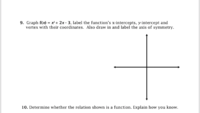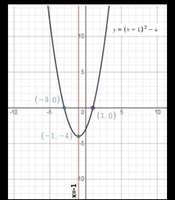rachelmaddie
Full Member
- Joined
- Aug 30, 2019
- Messages
- 851
Can someone please check my work? And I found this graph but I don’t know if it’s correct?


Rewrite this function in the vortex form.
f(x) = x^2 + 2x - 3
f(x) = x^2 + 2x + 1 - 1 - 3
f(x) = (x + 1)^2 - 4
The vortex is (-1, -4).
(1)
Comparing (1) to the standard vertex form
f(x) = (x - h)^2 + k
The vertex of function is at (h, k) = (-1, -4).
To find x-intercepts, put f(x) = 0
0 = (x + 1)^2 - 4
—> (x + 1)^2 = 4
Square root on both sides
x + 1 = +_2
x + 1 = -2 or x + 1 = 2
= x = -3 or x = 1
x intercepts: x = (-3, 0) and (1,0)
For y intercept put x = 0
f(1) = (1)^2 - 4 = 1 - 4 = -3
y intercept: y = (0, -3)
Axis of symmetry: -b/2a
In f(x) = x^2 + 2x - 3
a = 1 and b = 2
Axis of symmetry: -2/2(1) = -1


Rewrite this function in the vortex form.
f(x) = x^2 + 2x - 3
f(x) = x^2 + 2x + 1 - 1 - 3
f(x) = (x + 1)^2 - 4
The vortex is (-1, -4).
(1)
Comparing (1) to the standard vertex form
f(x) = (x - h)^2 + k
The vertex of function is at (h, k) = (-1, -4).
To find x-intercepts, put f(x) = 0
0 = (x + 1)^2 - 4
—> (x + 1)^2 = 4
Square root on both sides
x + 1 = +_2
x + 1 = -2 or x + 1 = 2
= x = -3 or x = 1
x intercepts: x = (-3, 0) and (1,0)
For y intercept put x = 0
f(1) = (1)^2 - 4 = 1 - 4 = -3
y intercept: y = (0, -3)
Axis of symmetry: -b/2a
In f(x) = x^2 + 2x - 3
a = 1 and b = 2
Axis of symmetry: -2/2(1) = -1
